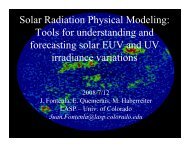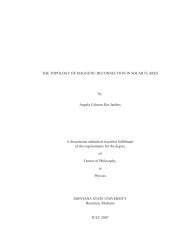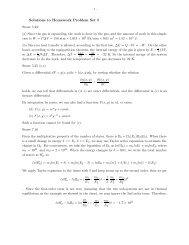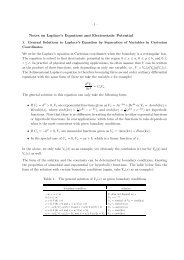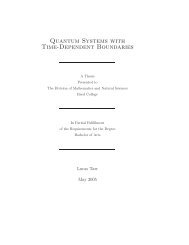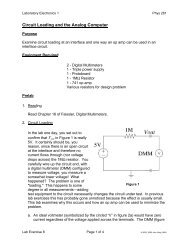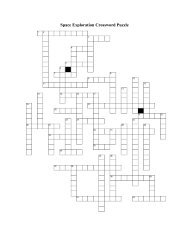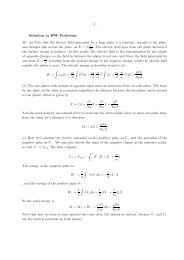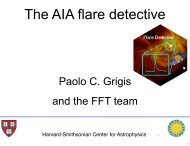An Introduction to the Conjugate Gradient Method Without the ...
An Introduction to the Conjugate Gradient Method Without the ...
An Introduction to the Conjugate Gradient Method Without the ...
You also want an ePaper? Increase the reach of your titles
YUMPU automatically turns print PDFs into web optimized ePapers that Google loves.
££§¢¡¡¡0¡¢¡¥ £¥ £¡§2£ ¥£2 ¢0¡¥2 £ ¦¦¦¦¦¦¦¦¦¤£¥¢¥¥3 ¢0¡ ¥¡ ¦ ¨ ¦¡ ¦ ¨ ¡ ¦ ¦¡ ¦ ¨1 £¢¢Convergence <strong>An</strong>alysis of <strong>Conjugate</strong> <strong>Gradient</strong>s 33error causes <strong>the</strong> search vec<strong>to</strong>rs <strong>to</strong> lose -orthogonality. The former problem could be dealt with as it wasfor Steepest Descent, but <strong>the</strong> latter problem is not easily curable. Because of this loss of conjugacy, <strong>the</strong>ma<strong>the</strong>matical community discarded CG during <strong>the</strong> 1960s, and interest only resurged when evidence for itseffectiveness as an iterative procedure was published in <strong>the</strong> seventies.Times have changed, and so has our outlook. Today, convergence analysis is important because CG iscommonly used for problems so large it is not feasible <strong>to</strong> run even § iterations. Convergence analysis isseen less as a ward against floating point error, and more as a proof that CG is useful for problems that areout of <strong>the</strong> reach of any exact algorithm.The first iteration of CG is identical <strong>to</strong> <strong>the</strong> first iteration of Steepest Descent, so without changes,Section 6.1 describes <strong>the</strong> conditions under which CG converges on <strong>the</strong> first iteration.9.1. Picking Perfect PolynomialsWe have seen that at each step of CG, <strong>the</strong> value ¢, wherespan¡ £¡ is chosen from ¢0¡span¡ ¢0¡¢0¡ 0¡Krylov subspaces such as this have ano<strong>the</strong>r pleasing property. For ¥ a fixed , <strong>the</strong> error term has <strong>the</strong> form0¡ 0¡£¡0¡The coefficients¢¦are related <strong>to</strong> <strong>the</strong> values¡ , but <strong>the</strong> precise relationship is not important here.What is important is <strong>the</strong> proof in Section 7.3 that CG chooses ¤ ¦coefficients that minimize § ¢¡§.<strong>the</strong>¢¦¡ and ¡ 1¢¢¥ ¦¢Let¦ ¡ ¨¥¥.¦if¦¡2¥¨ ¨¢£<strong>the</strong>n¦£2¥¡ £The expression in paren<strong>the</strong>ses above can be expressed as a polynomial. be a polynomial ofdegree can take ei<strong>the</strong>r a scalar or a matrix as its argument, and will evaluate <strong>to</strong> <strong>the</strong> same; for instance,221, 2 2 . This flexible notation comes in handy for eigenvec<strong>to</strong>rs, for,2. (Note that2, and so on.)which you should convince yourself that¦¥¨ £¦¥¡ ¨£ ¡Now we can express <strong>the</strong> error term as¨if we require that¦¥ 0¨ £ 1. CG chooses this polynomial when it chooses <strong>the</strong>¢¦0¡coefficients. Let’s¢£¦examine <strong>the</strong> effect of applying this polynomial ¢ 0¡ <strong>to</strong> . As in <strong>the</strong> analysis of Steepest Descent, ¢ expressas a linear combination of orthogonal unit eigenvec<strong>to</strong>rs0¡¦ ¦0¡¤ ¥ £ ¦and we find that1¦¢¢2 ¦¦¦¦2 ¡ ¦



